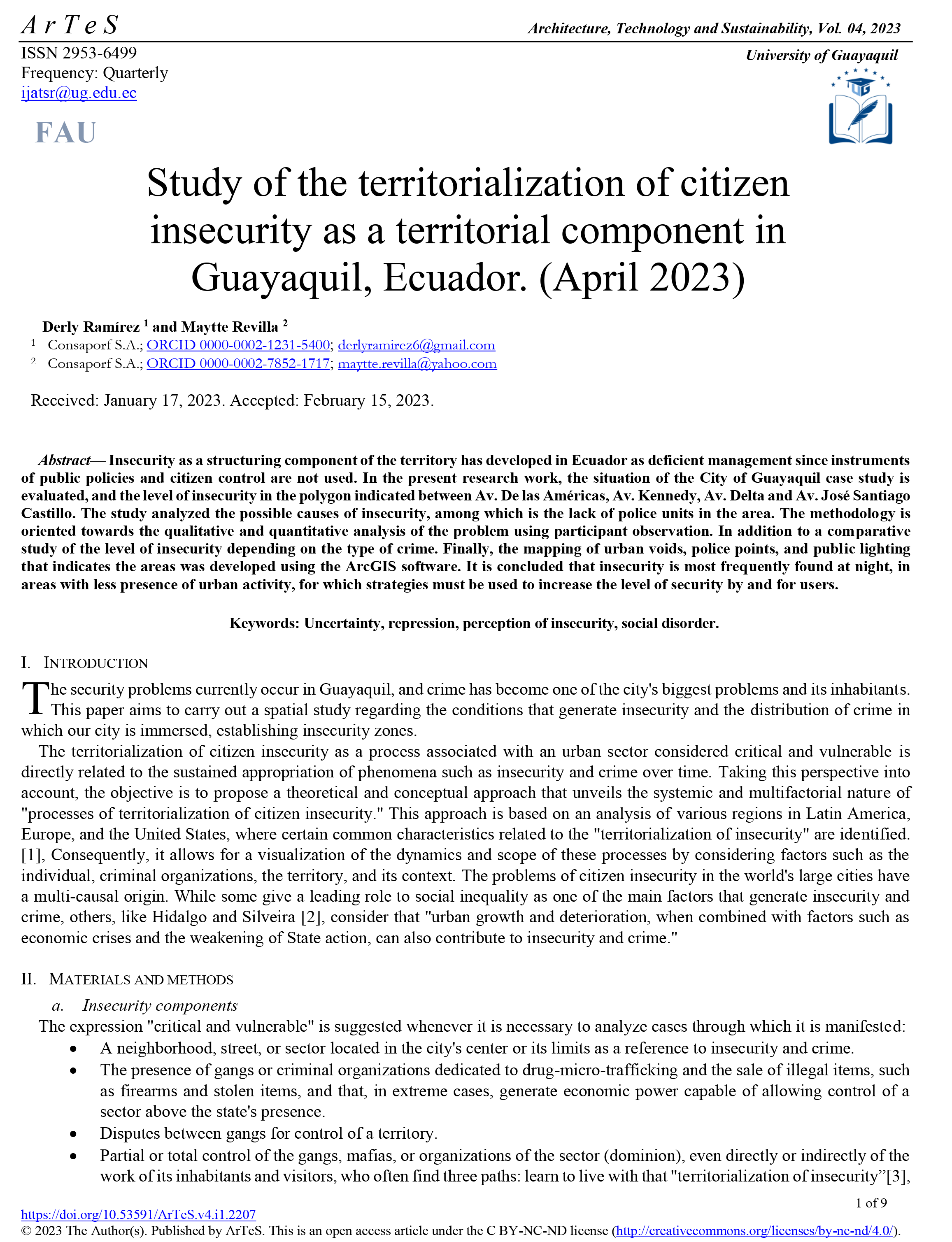Study of the territorialization of citizen insecurity as a territorial component in Guayaquil, Ecuador.
DOI:
https://doi.org/10.53591/ArTeS.v4.i1.2207Keywords:
Uncertainty, Repression, Perception of insecurity, Social DisorderAbstract
Insecurity as a structuring component of the territory has developed in Ecuador as deficient management since instruments of public policies and citizen control are not used. In the present research work, the situation of the City of Guayaquil case study is evaluated, and the level of insecurity in the polygon indicated between Av. De las Américas, Av. Kennedy, Av. Delta and Av. José Santiago Castillo. The study analyzed the possible causes of insecurity, among which is the lack of police units in the area. The methodology is oriented towards the qualitative and quantitative analysis of the problem using participant observation. In addition to a comparative study of the level of insecurity depending on the type of crime. Finally, the mapping of urban voids, police points, and public lighting that indicates the areas was developed using the ArcGIS software. It is concluded that insecurity is most
References
AC Rodríguez, “Recuperación de las características formales y espaciales de las viviendas vernáculas de nono (Ecuador) en contextos contemporáneos”, en Archivos Internacionales de las Ciencias de la Fotogrametría, la Teledetección y la Información Espacial - Archivos ISPRS, jul. 2020, vol. 54, núm. M–1, pp. 81–86. doi: 10.5194/isprs-annals-IV-5-W2-81-2019.
D. Hidalgo, F. Silveira, D. Padilha, AF Bassani e I. Nascimento, “Violência urbana e políticas de segurança: Análise em quatro ciudades latino-americanas”, Eure, vol. 47, núm. 141, págs. 165–182, 2021, doi: 10.7764/EURE.47.141.08.
MP López-Sánchez, T. Alberich, D. Aviñó, F. Francés García, A. Ruiz-Azarola y T. Villasante, “Herramientas y métodos participativos para la acción comunitaria. Informe SESPAS 2018”, Gaceta Sanitaria, vol. 32. Ediciones Doyma, SL, págs. 32–40, 01 de octubre de 2018. doi: 10.1016/j.gaceta.2018.06.008.
O. Peek, M. Hordijk y V. d'Auria, “Diseño basado en el usuario para una transformación urbana inclusiva: aprendizaje de las prácticas de vivienda 'informal' y 'formal' en Guayaquil, Ecuador”, Int. J. Hous. Policy, vol. 18, no. 2, pp. 204–232, abril de 2018, doi: 10.1080/19491247.2016.1265268.
JR Hechavarría Hernández, B. Forero y R. Vega Jaramillo, “Acceso universal y diseño de vivienda inclusiva para una familia en monte sinahí, Guayaquil, Ecuador”, en Advances in Intelligent Systems and Computing, 2020, vol. 1131 AISC, págs. doi: 10.1007/978-3-030-39512-4_166.
E. Lund y OR Bringa, “De las visiones a la política práctica: el viaje del diseño universal en Noruega. ¿Qué aprendimos? ¿Qué ganamos? ¿Y ahora qué?”, en Estudios en Tecnología e Informática de la Salud, 2016, vol. 229, págs. 43–52. doi: 10.3233/978-1-61499-684-2-43.
M. Ginzarly, A. Pereira Roders y J. Teller, “Mapeo de valores históricos del paisaje urbano a través de las redes sociales”, J. Cult. Herit., vol. 36, págs. 1–11, marzo de 2019, doi: 10.1016/j.culher.2018.10.002.
A. Serra-Llobet y MA Hermida, “Oportunidades para la infraestructura verde bajo el nuevo marco legal de Ecuador”, Landsc. Urban Plan., vol. 159, pp. 1–4, mar. 2017, doi: 10.1016/J.LANDURBPLAN.2016.02.004.

Downloads
Published
How to Cite
Issue
Section
License
Copyright (c) 2023 Derly Tamara Ramírez Aguilar, Maytte Ivonne Revilla Espinoza

This work is licensed under a Creative Commons Attribution-NonCommercial-NoDerivatives 4.0 International License.



